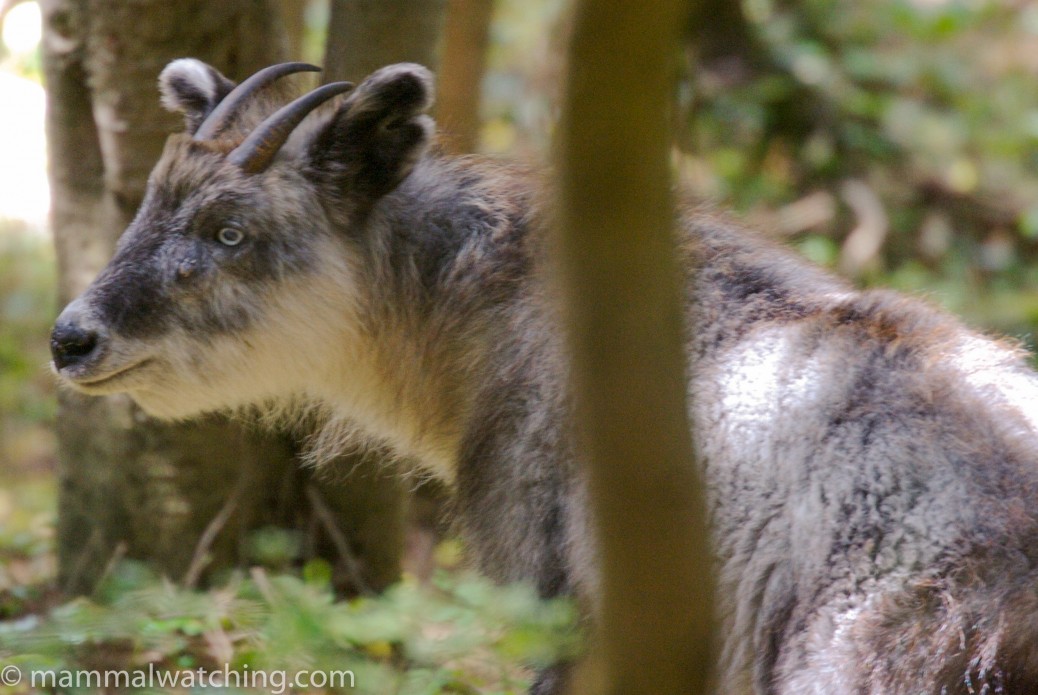
Japan
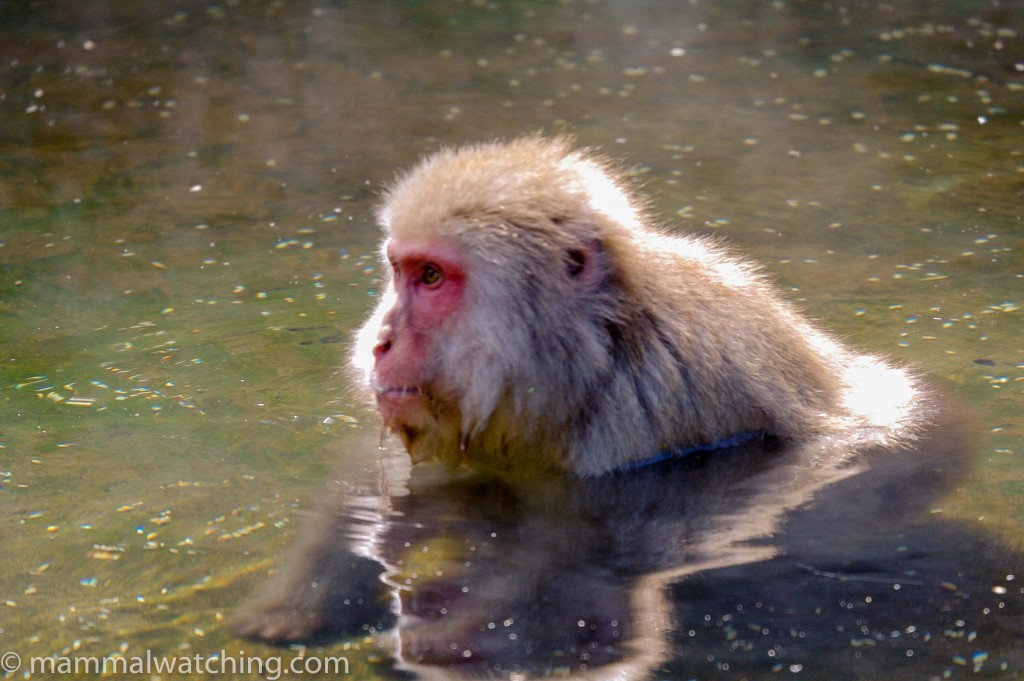
Japanese Macaque, Macaca fuscata, Jigokudani
I’ve been to Japan seven times and I love it. I first visited in October 2007, when I had a spare weekend during a work trip to Korea and went to the Japanese Alps. I returned to Kyoto for a conference two weeks later. In 2009 I was back for work in Kyoto and Tokyo. In August 2016 I returned for a few days at a conference in Tokyo, but squeezed in a night on Amami Island and another in the Tateshina area of the Japanese Alps. And I spent 10 days there on (a mainly non-mammal) holiday with my daughter in April 2018 and again for three days in Nagano in July 2018. We returned – this time to Hokkaido -in January 2024 for three nights.
Until I got there I was under the impression that Japan was heavily urbanised and crazily expensive. It isn’t. It is also immaculately clean and incredibly polite: quite the culture shock from Paris or New York
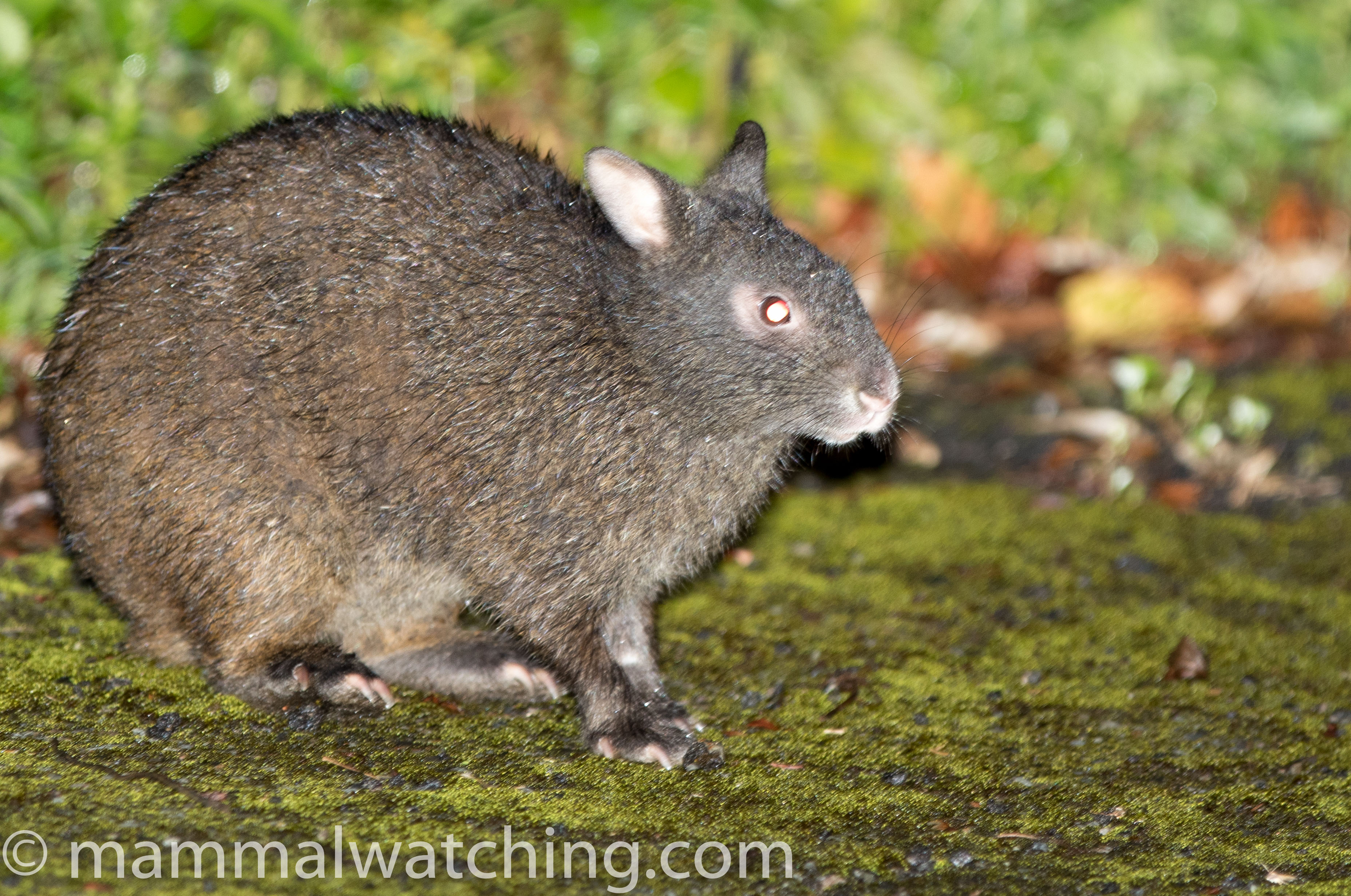
Amami Rabbit, Pentalagus furnessi, Amami Island
Amami Island
I spent one night here in August 2016. The fabulous endemic Amami Rabbits, the main reason for my visit, were easy to see. And I was lucky enough also to find a couple of the very rare giant Ryuku Long-furred Rats. A full report is here.
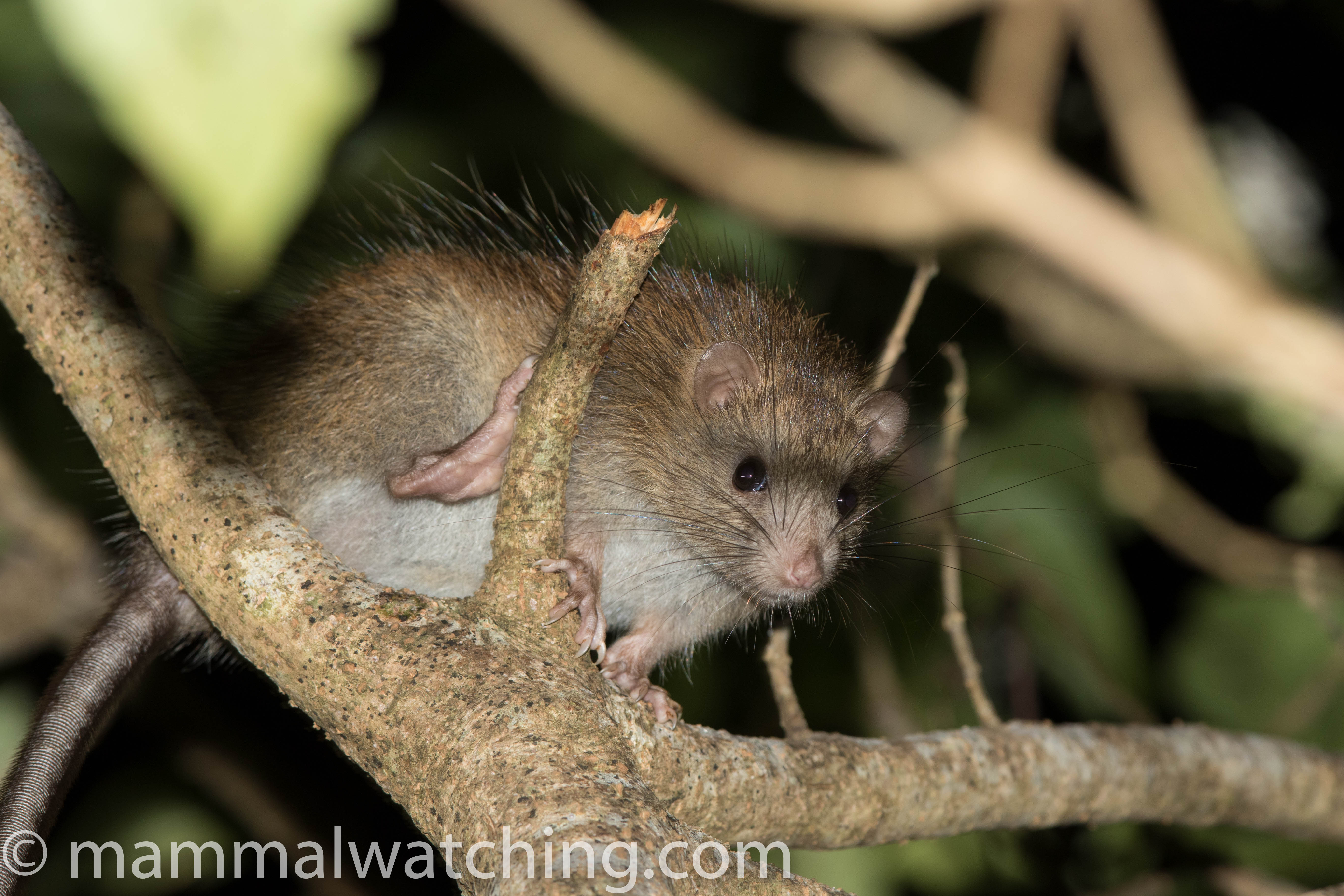
Ryukyu Long-furred Rat, Diplothrix legata
Hokkaido Island
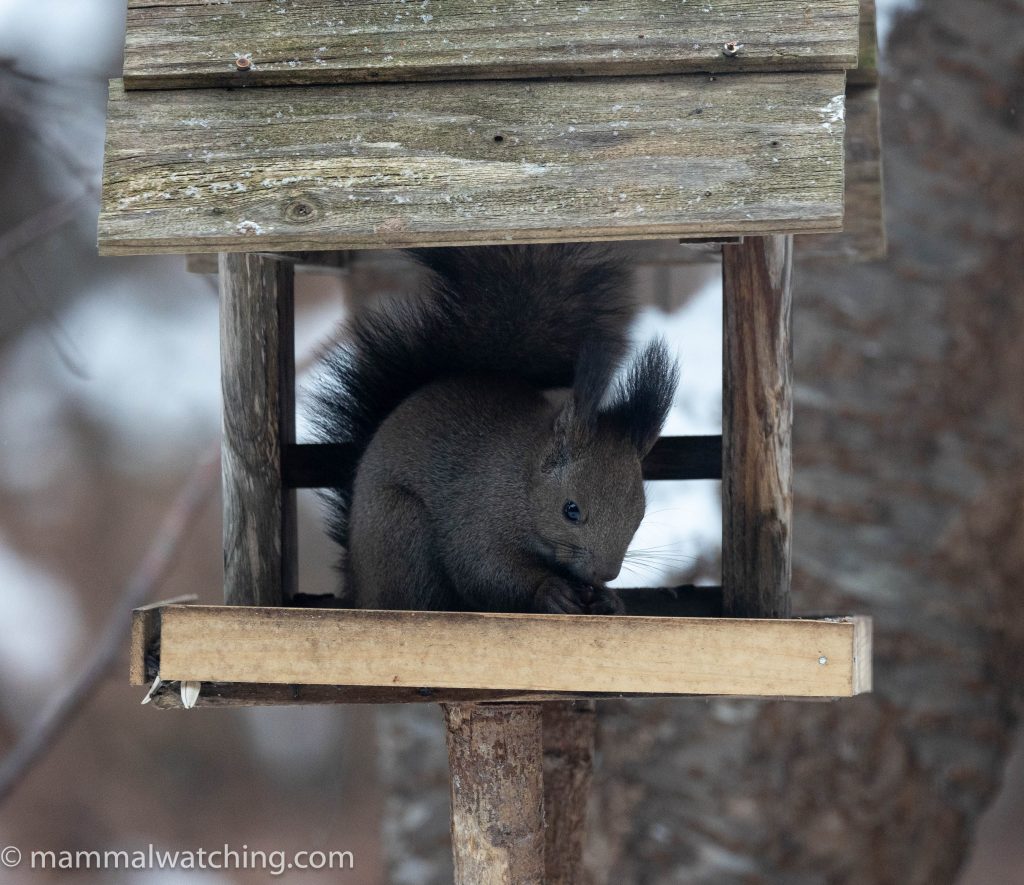
Japanese (Eurasian) Red Squirrel (Sciurus vulgaris orientis)
Two nights in at Yoruushi Onsen in January 2024 produced Red Fox, Red Squirrel and feral American Mink but not the Sable I had been hoping for. We also saw Sika Deer around Nemuro.
HOnshu Island
Aomori Prefecture
I haven’t been here, but Dave Pullan, a wildlife photographer, visited in January 2010 after tracking down a site for Japanese Martens (not without considerable effort) which he was good enough to share with me for the site.
The Japanese Martens were in Aomori prefecture which is at the northern end of Honshu, at a guesthouse (hot spring baths) called Yachi Onsen: Hakkoudasan, Naka,Yachi Onsen,Towada City, Aomori Prefecture. Tel: 0176-74-1181.
We caught a train from Tokyo to Hachinohe and then a hire-car from Hachinohe to Yachi Onsen (1 hour 45 mins drive). I eventually got the information I needed from a Japanese researcher who had been using camera-traps for Martens on the island of Tsushima. Apparently food-scraps are thrown out from the kitchen at the back of the guesthouse, and although we never saw this happen the Martens were coming very close to the building.
We saw 3 Martens on 2 consecutive nights: 30th January (1830-1900hrs) and 31st January (1725-1930hrs). It is best to get a room that looks out from the back of the building.
No-one speaks English at the Onsen, so if you get a chance to go there I would suggest getting a Japanese contact to do all the arrangements including emphasising that you want to see the Martens. They are used to Japanese photographers visiting for this purpose judging by the number of framed Marten photos on the walls.
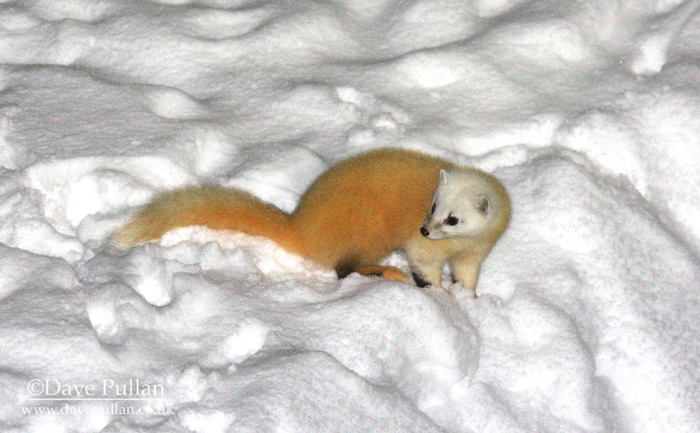
Japanese Marten, Martes melampus. Photo Dave Pullan
Kyoto Prefecture
Kyoto isn’t a great spot for mammals. I had a spare morning here in late October 2007 and decided to look for a Japanese Squirrel. I spoke to a few locals none of whom had ever seen a squirrel in town, but a 1997 birding report listed one on Daimonji Hill (behind the Ginkakuji Temple). The walk up the hill is through some nice forest (a network of trails run over the hill – ask at the temple for directions to the trail head). I imagine that there are still squirrels there but I didn’t see any.
Nagano Prefecture
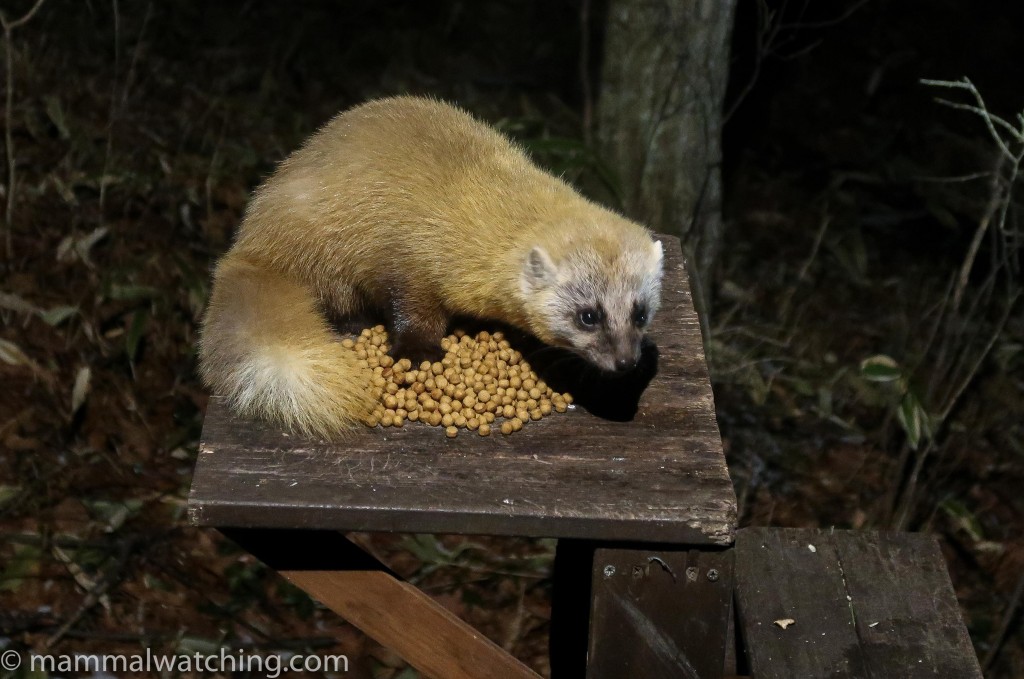
Japanese Marten, Martes melampus. Bergcot Guesthouse, 2018
Karuizawa and around
When I first visited Japan it was just for a weekend, in the middle of a work trip to Korea. I decided to spend Saturday and Sunday in the Japanese Alps, about an hour and a half’s bullet train ride from Tokyo. Japan’s rail system is breathtakingly efficient, and getting to the mountains from Tokyo was easy. You need an international driving licence to hire a car, which I didn’t have, so I found a local guide – Chie Nagashima, from the Karuizawa Guide Service – who was able to take me round in her vehicle for not much more than it would have cost to have hired a car.
Japan’s customer service is legendary and Chie was no exception. After I explained I wanted to see some of the area’s mammals she must have phoned about 30 people to get advice on where to go, what to look for, and where to stay. Her English is perfect and she answered my messages within a couple of hours despite the 7 hour time difference. Japan 1 – France 0!
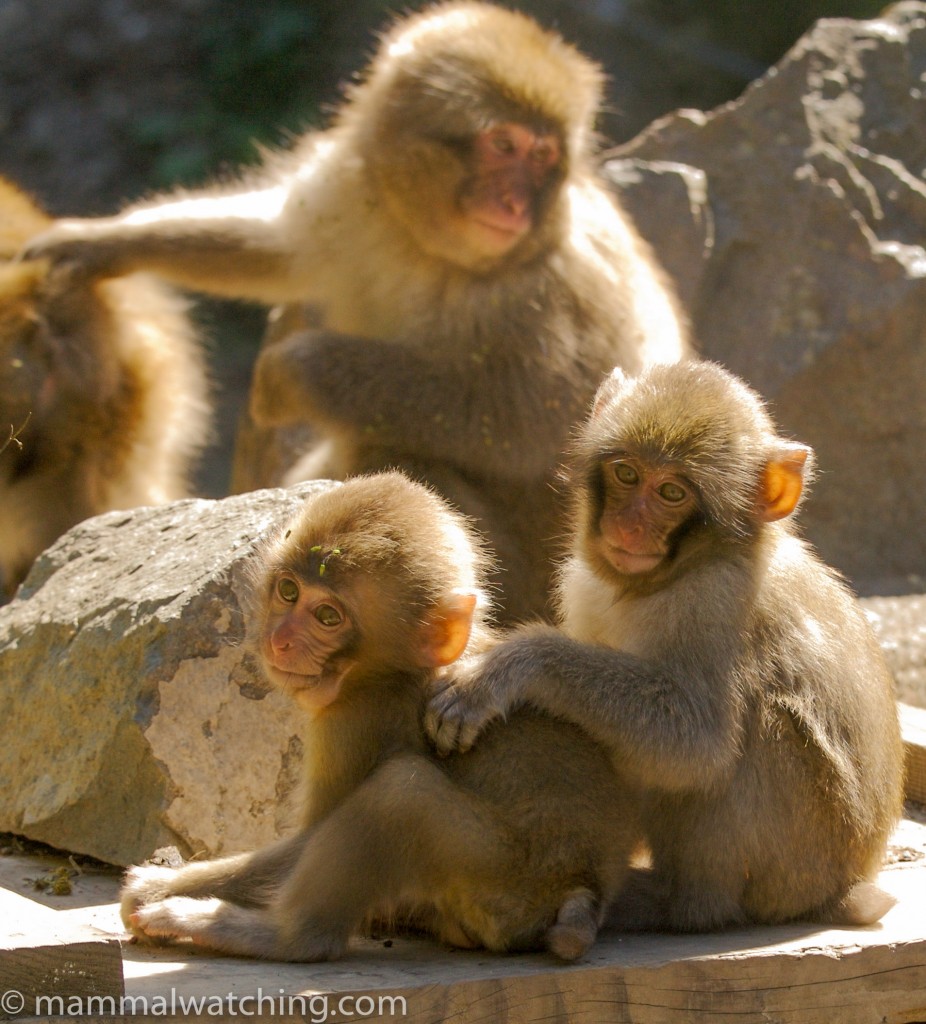
Japanese Macaques, Macaca fuscata
I puled into Nagano Station at 8.04 (precisely of course), met Chie and we drove for about an hour to the car park near the Jigokudani wild monkey park, home to a large population of Japanese Macaques. The wild monkey park is essentially a small area around a hot spring where the monkey’s gather each day: these are the famous Snow Monkeys who bathe in the hot springs.
The animals are wild and live in the surrounding forest but they are – I understood – fed by the people from the park. When we arrived there was just a lone macaque sitting on the roof of the Jigokudani hotel. About 40 minutes later at least 50 macaques came out of the forest.
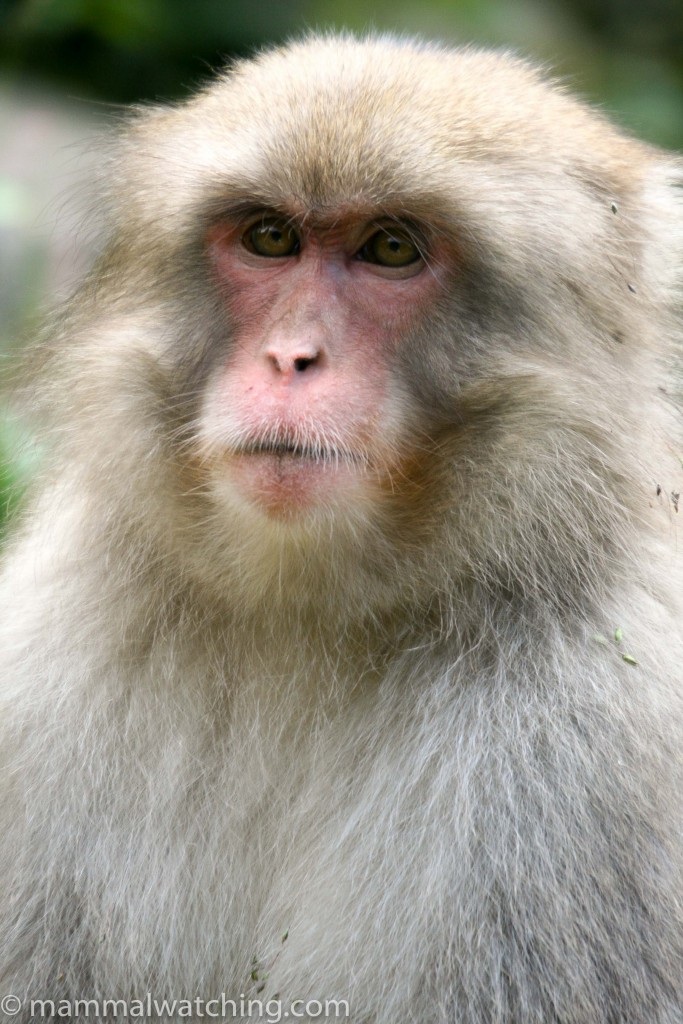
Japanese Macaque, Macaca fuscata
The hotel and park are a 20 minute walk through the forest. Japanese Serow are quite often reported from here though I didn’t see any. I did find a dead white-toothed shrew (species unknown) on the trail though.
From here we drove on to Karuizawa, 2 hours drive from Jigokudani and also on the Bullet Train route from Tokyo. It is a popular place for birdwatchers and seemed like a good base for the rest of the weekend. I stayed at the Shiotsubo Onsen hotel. A nice spot at the edge of the forest where Japanese Squirrels (Sciurus lis), a Karuizawa town emblem, often visit the bird tables. The squirrels, it seems, are not very active at this time of the year: they are asleep by 4p.m. and most likely to visit the bird tables between 8 and 10 am. I was only at the hotel in the late afternoons and very early mornings so I guess it wasn’t surprising that I didn’t see any squirrels
A nature tour/research company called Picchio are based in Karuizawa. As well as running group tours through the forest they do some research including monitoring some of the 19 radio collared Asiatic Black Bears in the area.
Picchio run a dusk nature walk at the weekends which is mainly aimed at young children. It was excellent, not least because Japanese Giant Flying Squirrels are virtually guaranteed. There are several squirrel nestboxes around the Picchio offices each of which are monitored by CCTV. At dusk the tour begins with a wait outside an occupied nest box for an animal to emerge. They don’t allow flash photography hence the crappy picture below, but the beast itself was superb.
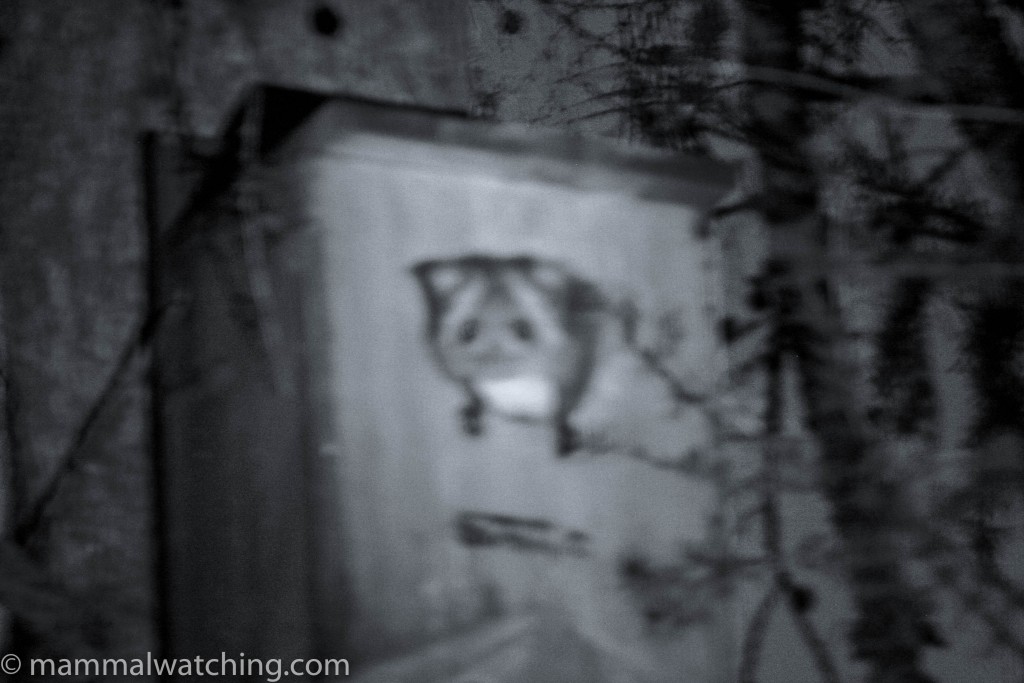
Japanese Giant Flying Squirrel, Petaurista leucogenys
After we had seen the squirrel emerge and glide into the forest we visited a small pond up the road. Using bat detectors the Picchio people were confident that the common species skimming the pond were Big-footed Myotis (Myotis macrodactylus). Another species was probably a Bird-like Noctule (Nyctalus aviator): it certainly sounded like a Noctule on the detector though the guide was not completely confident because the species is apparently rare in the area.
I particularly wanted to see two other species around Karuizawa: Japanese Martens and Japanese Serows, neither of which are uncommon. Chie drove me spotlighting around the area after dark but it was cold and I was tired and all we saw was a Field Mouse bouncing across the road. Japanese Hares, Japanese Raccoon Dogs, Japanese Flying Squirrels and Sika Deer are some of the other species around.
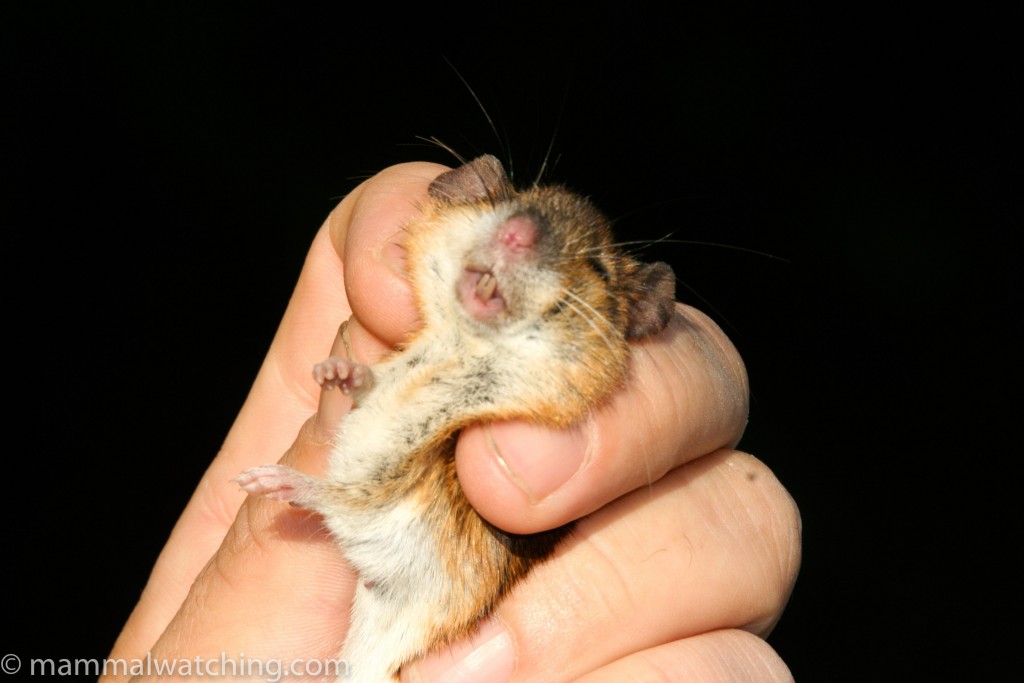
Large Japanese Field Mouse, Apodemus speciosus
The hotel didn’t mind me setting a few Elliot traps around the edge of the car park and the next morning I had caught two Large Japanese Field Mice (Apodemus speciosus). Apparently Small Japanese Field Mice (Apodemus argenteus) are also quite common but they are smaller and have a tail longer than the head-body (the species I caught had a head body length of about 110 mm and tails about 95 mm long).
I spent the rest of the day on a Picchio guided walk up Mt Asama, an excellent place to see Japanese Serow.
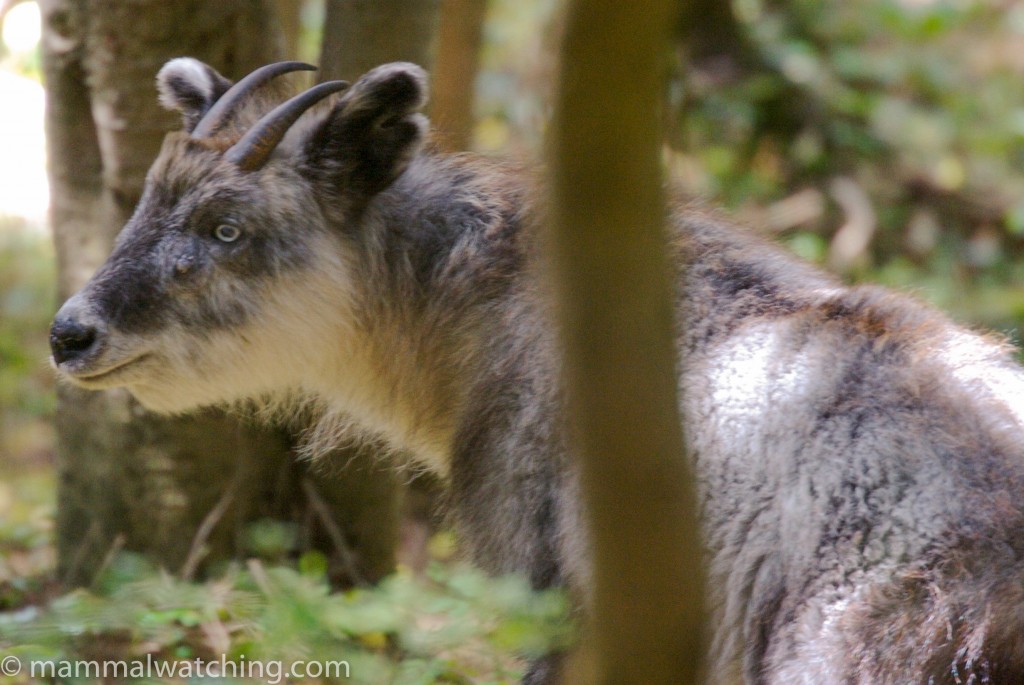
Japanese Serow, Capricornis crispus
Eight of us took the tour and the two guides both spoke pretty good English and were knowledgeable about the fauna. They had been running the tour for several years and Serows were virtually guaranteed. They had seen few other mammals on the walks.
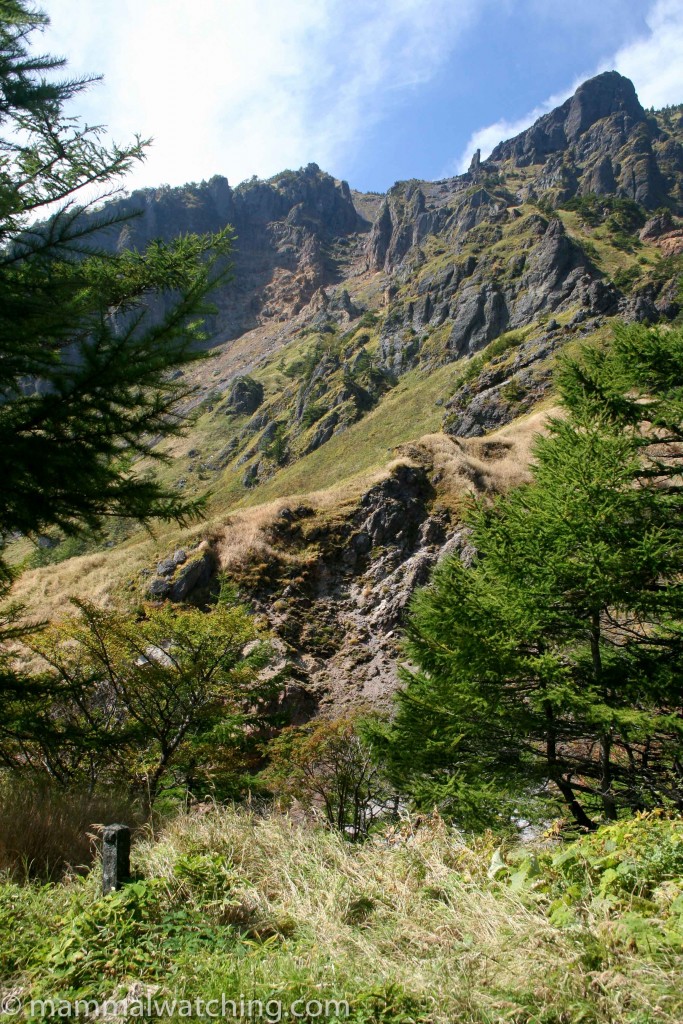
Mt Asama, Serow habitat
The weather was beautiful and the trail easy going. The Serows hang out about 3km up the mountain near the shelter. We saw three animals close up and another one distantly. They are habituated to people and so very approachable.
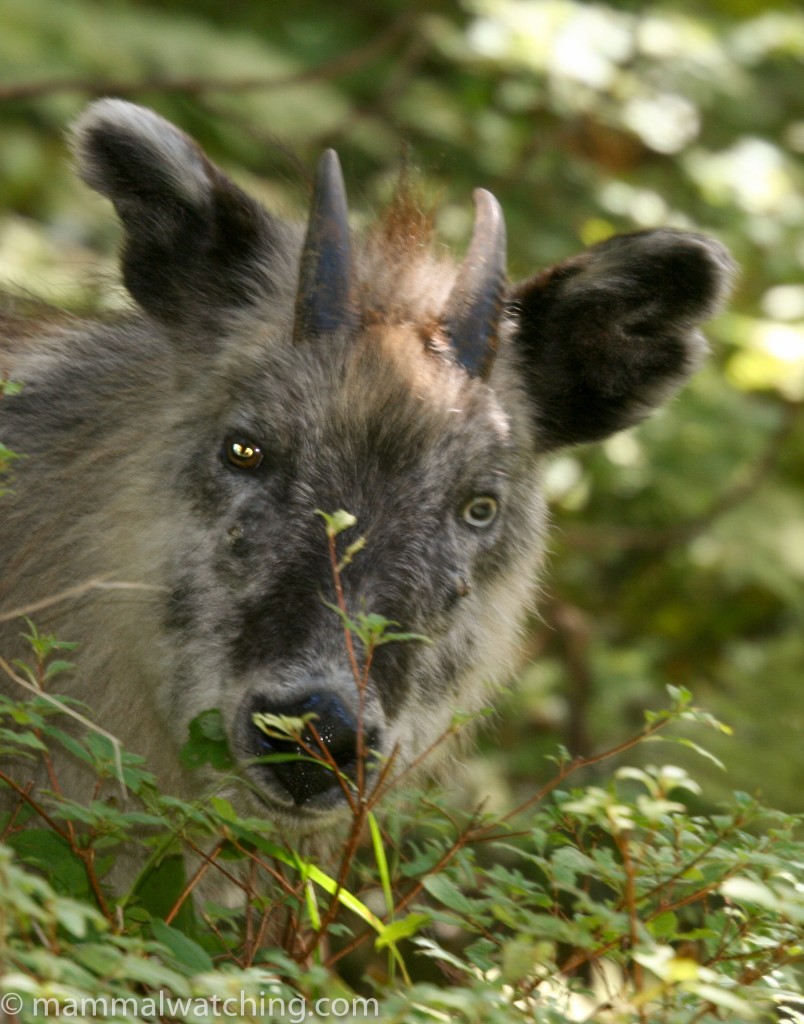
Japanese Serow, Capricornis crispus
A spotlight drive deeper into the mountains that evening went through nice habitat but we didn’t see a single animal.
In July 2018 I returned to Karuizawa for a night and took a night safari with Picchio. We saw several Japanese Hares, many Sika Deers and a Red Fox. But not the Japanese Badger they see one night in ten.
Chino and around
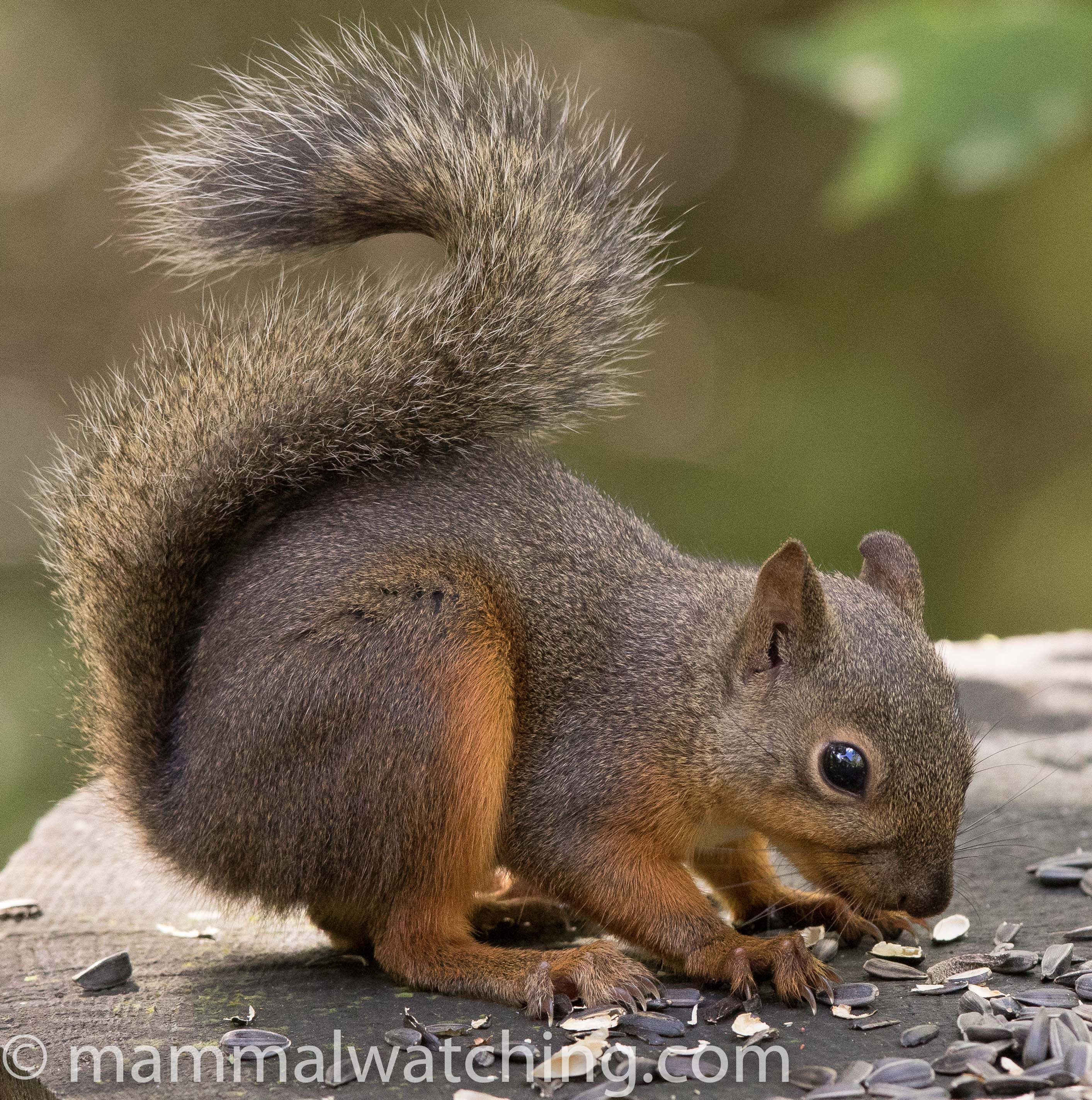
Japanese Squirrel, Sciurus lis
In August 2016 I returned to the Alps for a night in Tateshina. I didn’t see the Japan Badger that usually visits the guest house, but did see a Japanese Squirrel and caught Japanese Shrew-Moles, and both Large and Small Japanese Field Mice in the garden. See my 2016 trip report.
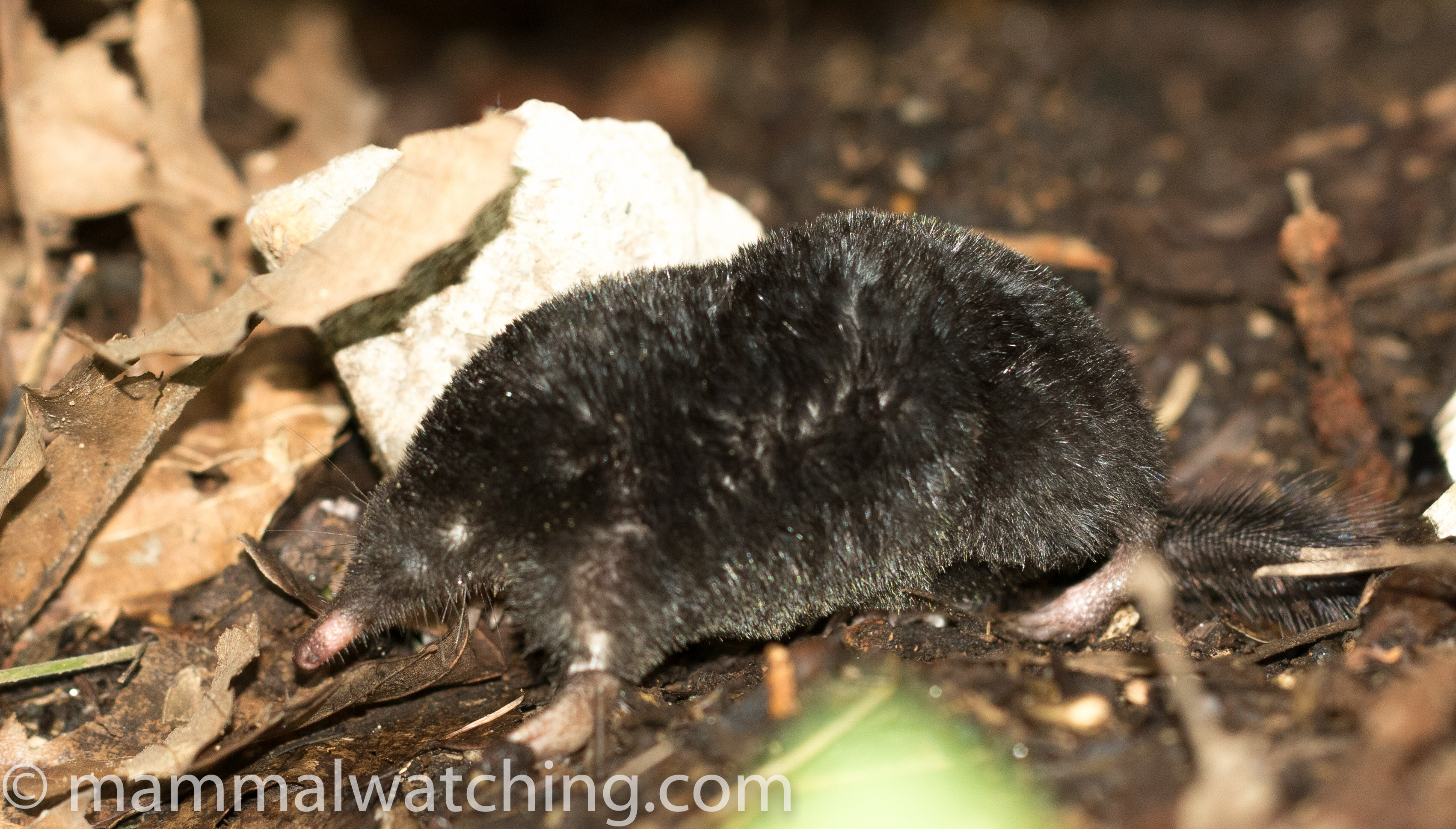
Japanese Shrew-mole, Urotrichus talpoides
I returned to lovely Bergcot in April 2018. The badger was still hibernating I think, but I had great views of a pair of Japanese Martens and a pair of Japanese Raccoon Dogs at the feeding station. There were Sika Deer on the road nearby. I spent a night there in July 2018 too but saw only a Raccoon Dog.
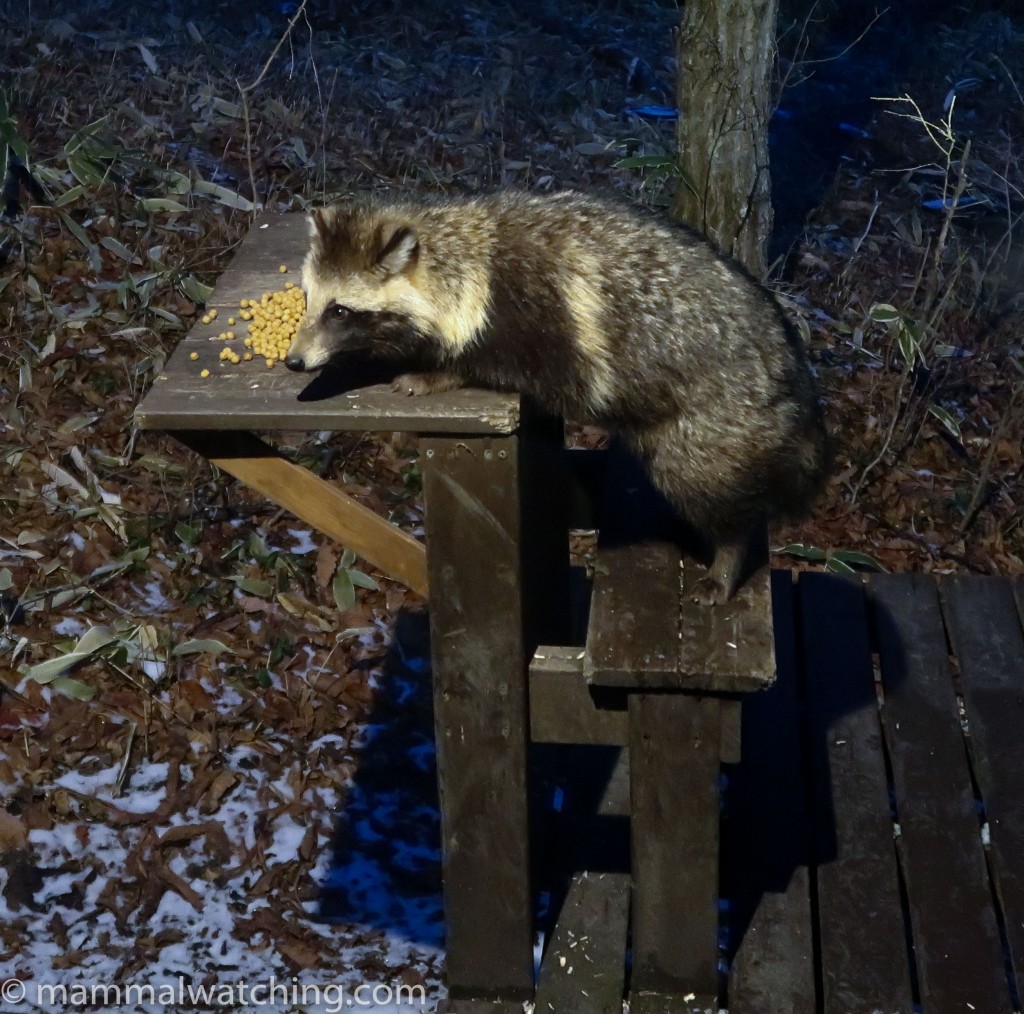
Japanese Raccoon Dog, Nyctereutes viverrinus
In July 2018 I spent a great night at Yamabiko Sou, a mountain cabin on Mount Io near Chino.
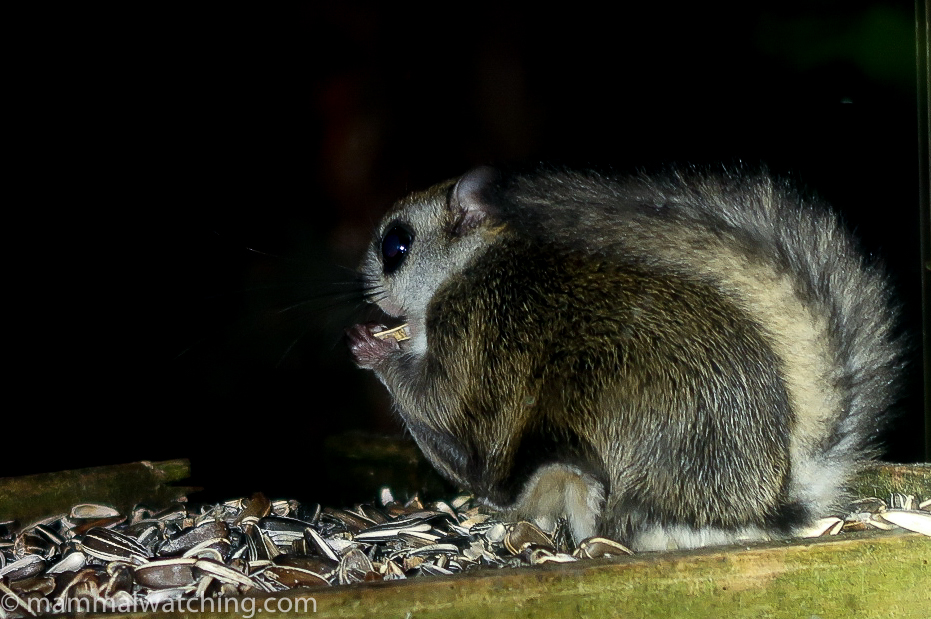
Japanese Dwarf Flying-Squirrel, Pteromys momonga
Japanese Dwarf Flying Squirrels and Japanese Dormice visit the feeding station there at night and a Japanese Marten showed up too. There were Japanese Squirrels in the daytime. Asian Parti-coloured Bats live in the roof, and inside the cabin I saw Small Japanese Field Mice and a Japanese Grass Vole. See my July 2018 report for more details of how to visit this wonderful place.
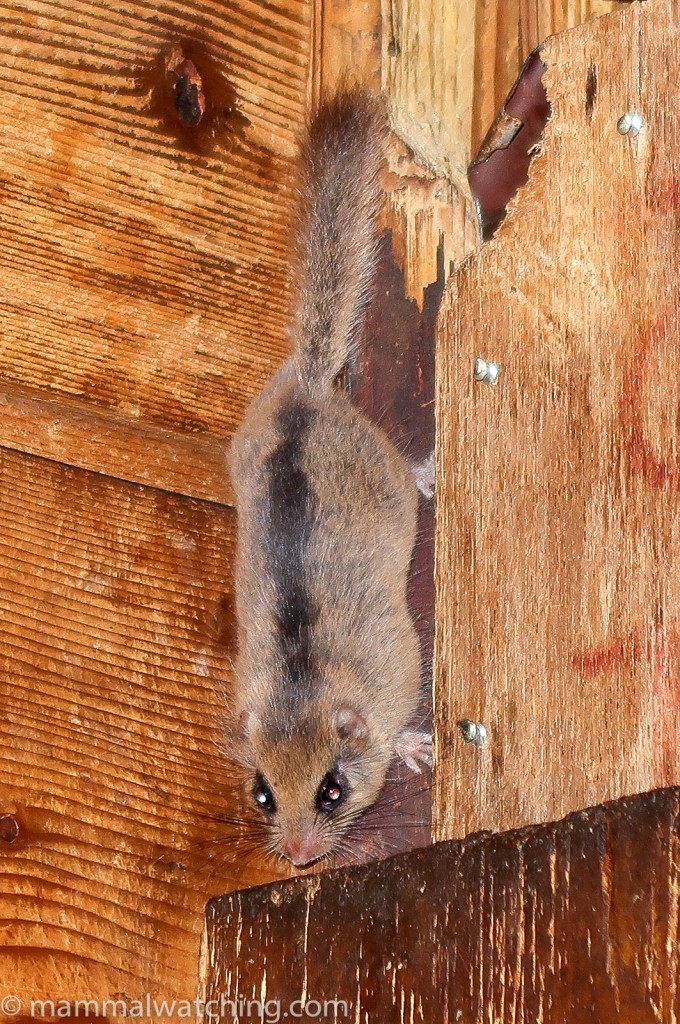
Japanese Dormouse, Glirulus japonicus
Nara Prefecture
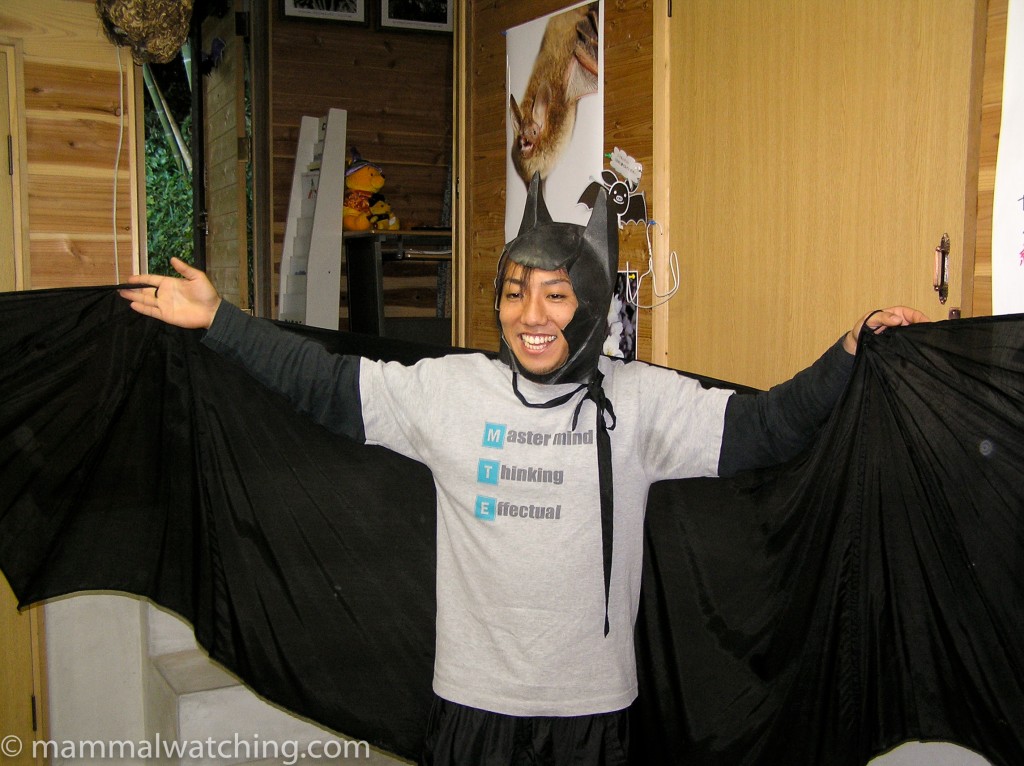
Nara is about 50 minutes by train from Kyoto. Before I first visited in 2007 I had gotten in touch with Professor Kishio Maeda from Nara University of Education, one of Japan’s foremost bat experts. He was super nice, and proof that the friendliness of bat biologists extends to Japan. Although he was busy arranged for three of his graduate students to meet me at the station and take me to see some bats.

Bat researchers
We drove about an hour and a half out of Nara into the mountains via the small and quirky Asian Bat Research Institute Museum which was very nicely laid-out with specimens of the Japanese species and all manner of bat-related paraphernalia.
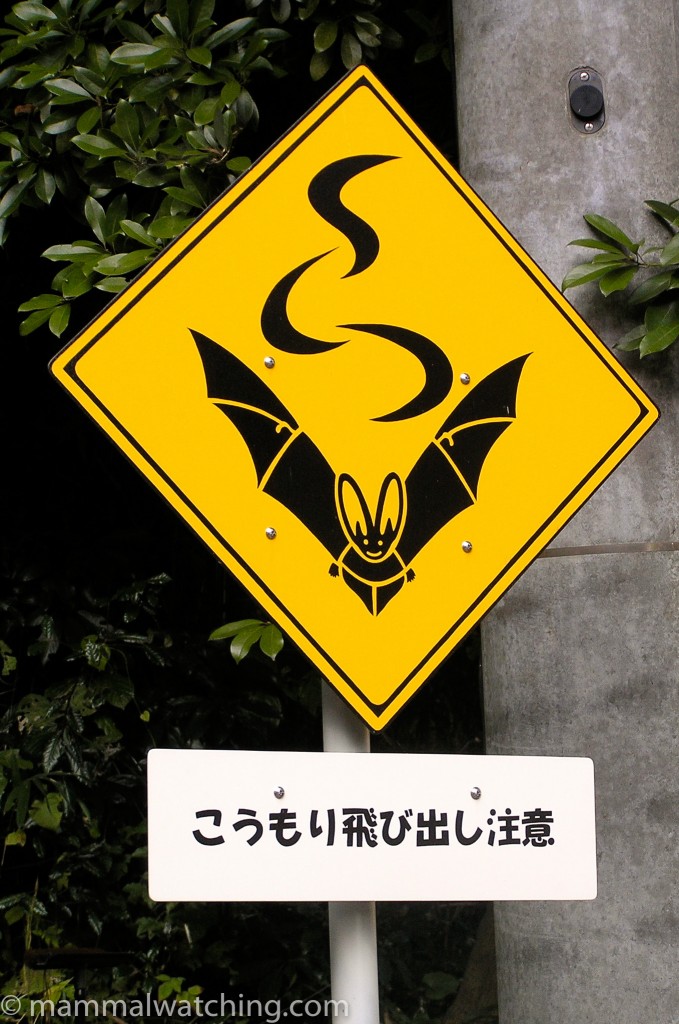
Our destination was a long abandoned road tunnel which ran for 70 metres before it had collapsed or been filled in. Several species of bats use it only as a hibernacula and it is used year round by others. We caught and banded two endemic species.
The first species were Eastern Bent-winged Bats (Miniopterus fuliginosus), a recent split from M. schriebersii though not yet on the IUCN Redlist.
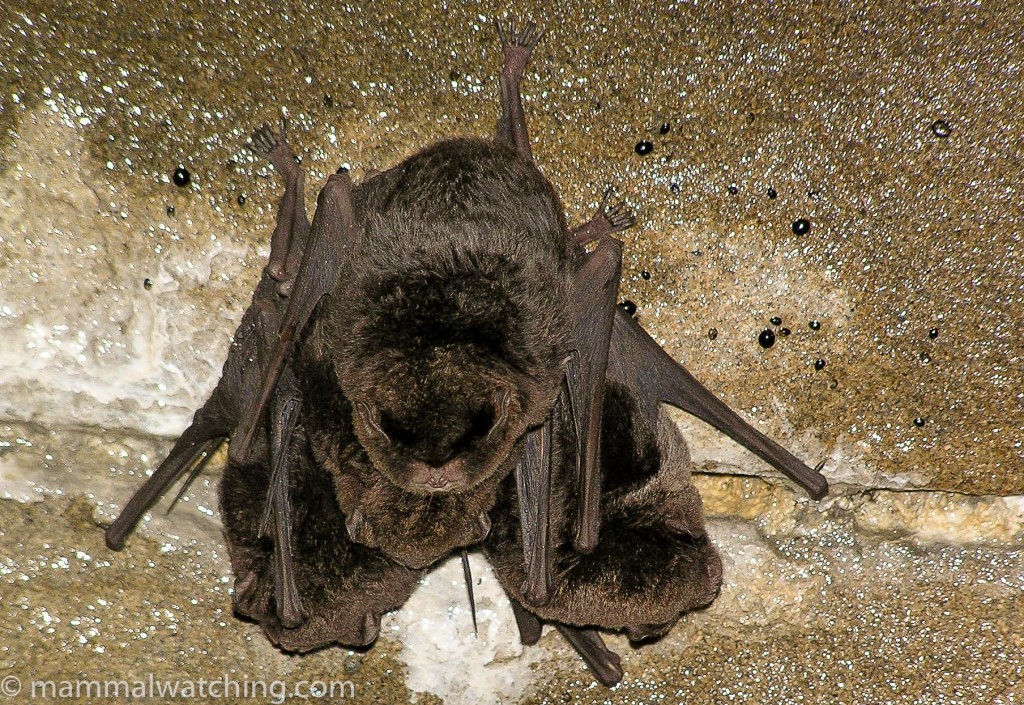
Eastern Bent-winged Bats, Miniopterus fuliginosus
The second species was a Little Japanese Horseshoe Bat (Rhinolophus (pusillus) cornutus). Big-footed Myotis (Myotis macrodactylus) are usually present but we couldn’t see any.
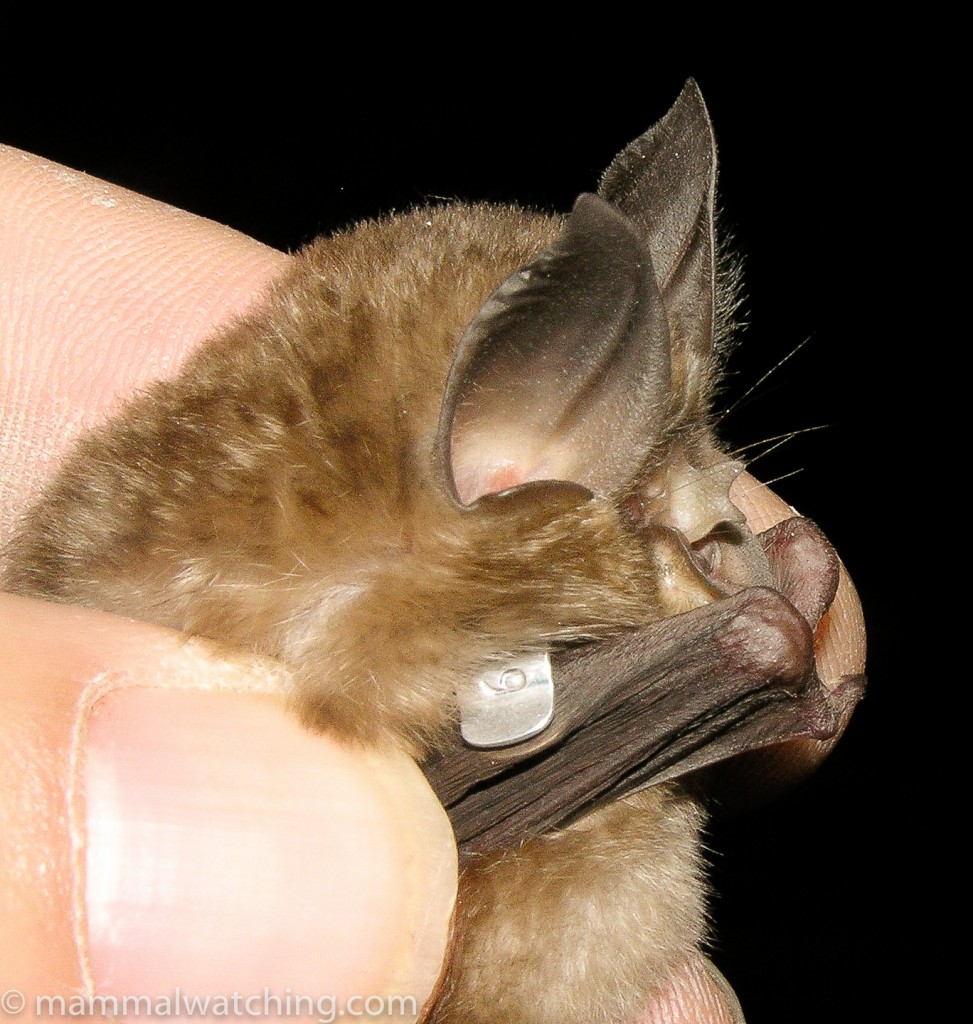
Little Japanese Horseshoe Bat, Rhinolophus (pusillus) cornutus
Back at the bat museum the detector picked up what was probably a Japanese Pipistrelle (Pipistrellus abramus) feeding near the river but we couldn’t see it. Sika Deer are common in the parks in and around Nara as are Japanese Raccoon Dogs (I saw roadkill but didn’t go looking for them at night). Many thanks to Prof. Maeda and his excellent students!
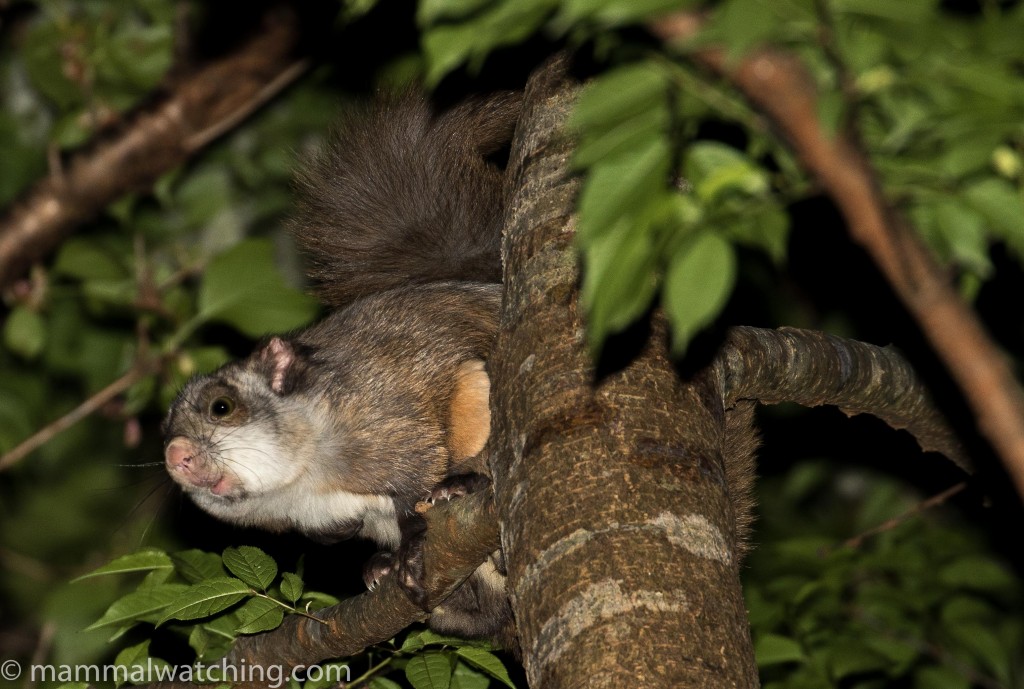
Japanese Giant Flying Squirrel, Petaurista leucogenys
In April 2018 I spent a few hours spotlighting around Kagayama Primeval Forest. Japanese Giant Flying Squirrels were abundant, as were Sika Deer on the edges of the forest. I couldn’t properly identify the other animals I saw but think a Japanese Marten was among them.
Shiga Prefecture
In March 2009 I was in Japan for work and had less than a day of mammal time. I got in touch again with my friend Professor Kishio Maeda at Nara Uni, who I got to know in 2007. He was as generous as always. Not only did he set up a trip to show me some mammals but also threw an impromptu roll your own sushi party with some of his bat friends. A lot of fun and the sushi was probably the best I’ve ever had.
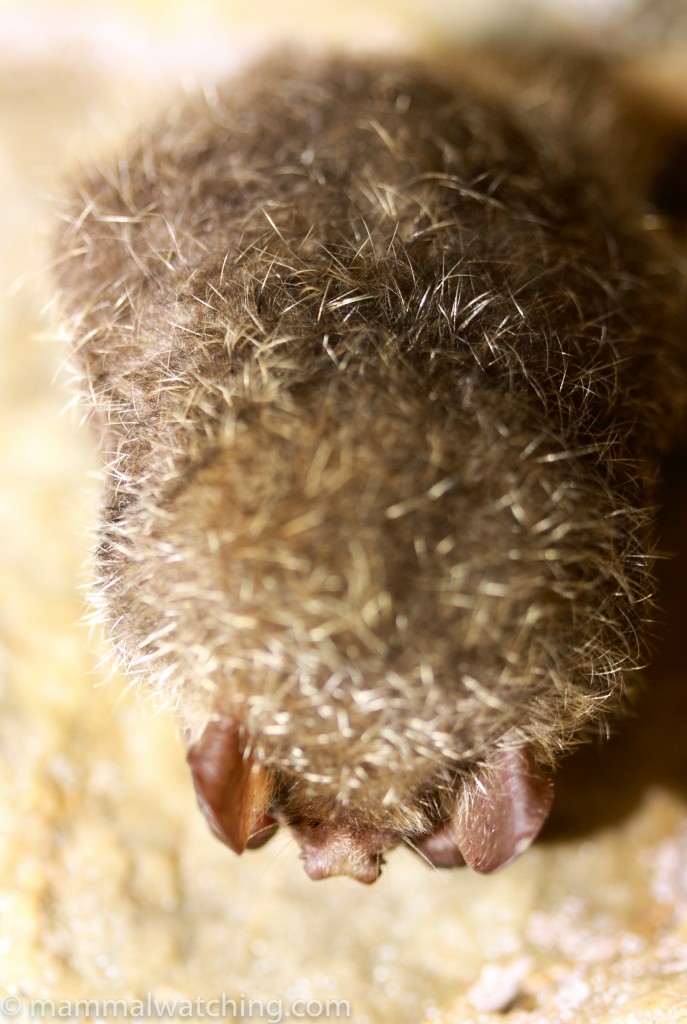
Hilgendorf’s Tube-nosed Bat, Murina hilgendorfi
The next day we took a trip to Taga-cho, a 2 hour drive north east of Nara. The Kawachi No Kaza-Ana Cave is 15 minutes out of town and open to the public with a small charge to enter. Several species of bats use the cave but the Hilgendorf’s Tube-nosed Bats (Murina hilgendorfi) are the most interesting. This species has from time to time been thought to be synonymous with Murina leucogaster, but most now consider it a full species in its own right.
A small population starts to build up from early February, peaking in late April and disbursing by the start of June. Fewer than 200 bats use the cave.
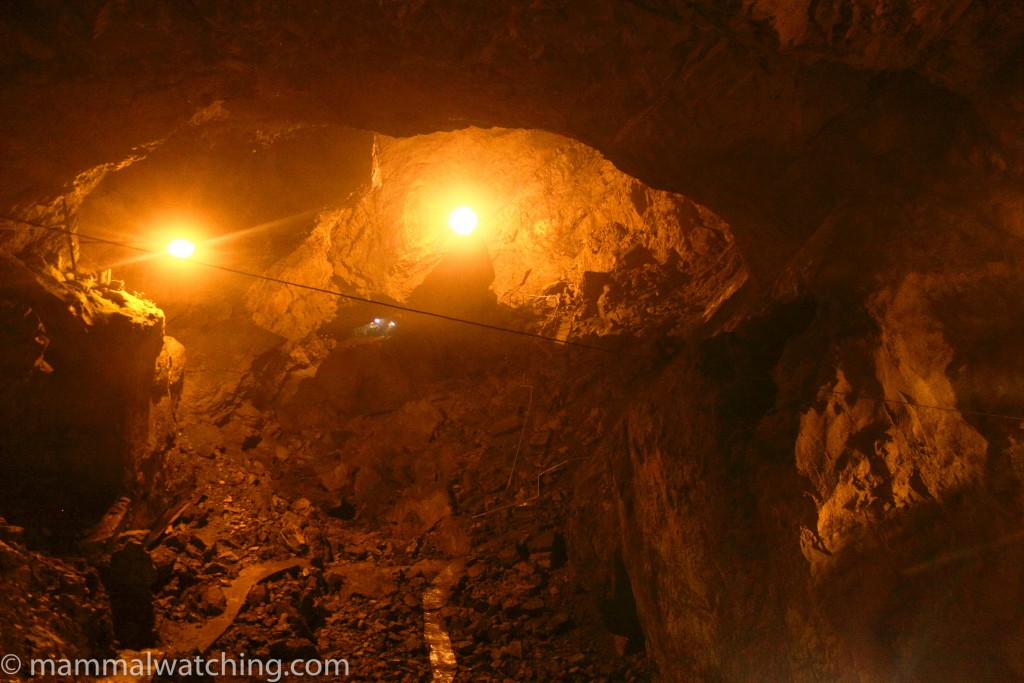
Kawachi No Kaza-Ana Cave
The bats were easy to see and roosted in ones and twos on the roof and walls, sometimes within touching distance.
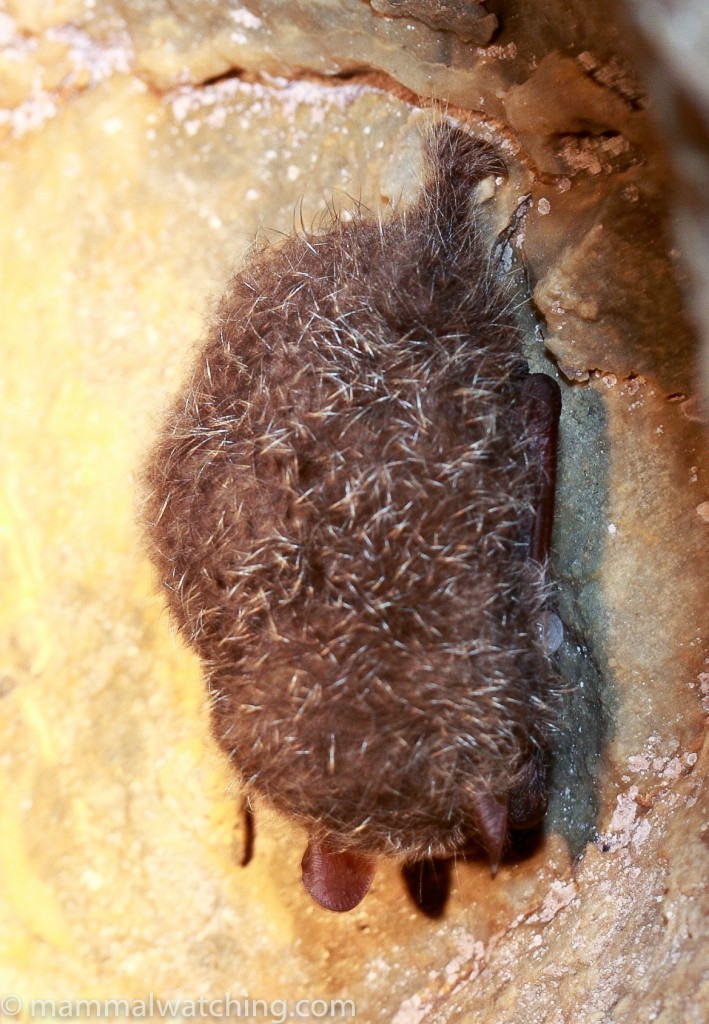
Hilgendorf’s Tube-nosed Bat, Murina hilgendorfi
Several other species use the cave and we saw Greater Japanese Horseshoes, Eastern Bentwings and a couple of Japanese Large-footed Bats (Myotis macrodactylus).
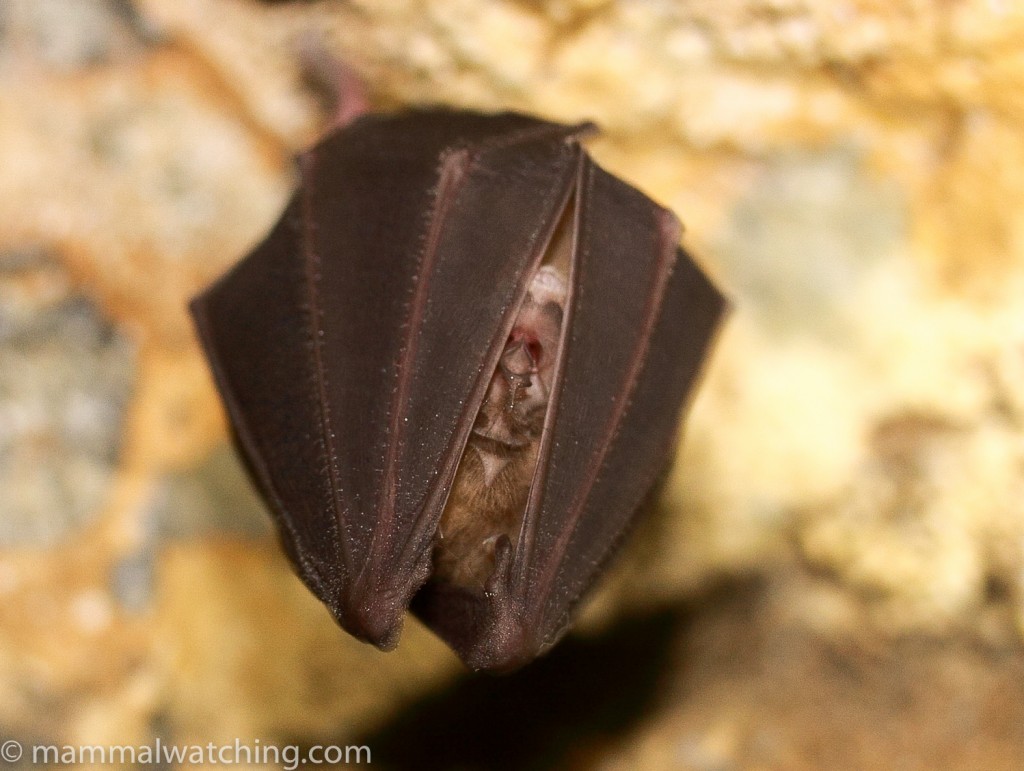
Greater Horseshoe Bat, Rhinolophus (ferrumequinum) nippon
A sincere thank you again to Kishio Maeda for indulging me in sushi and species.
Kyushu Island
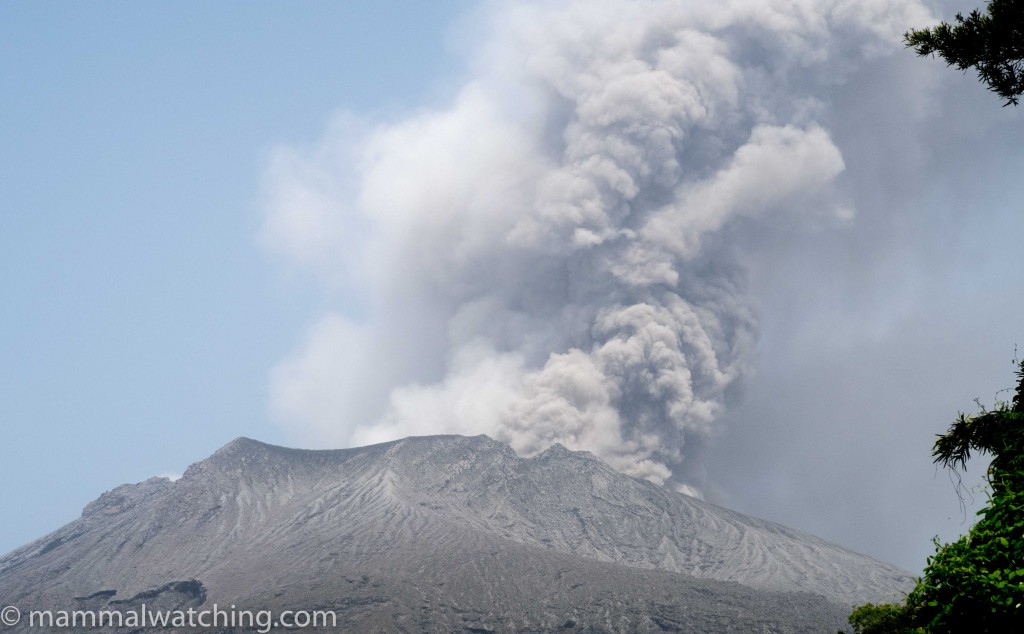
Sakurajima Volcano, near Kagoshima
Kagoshima Prefecture
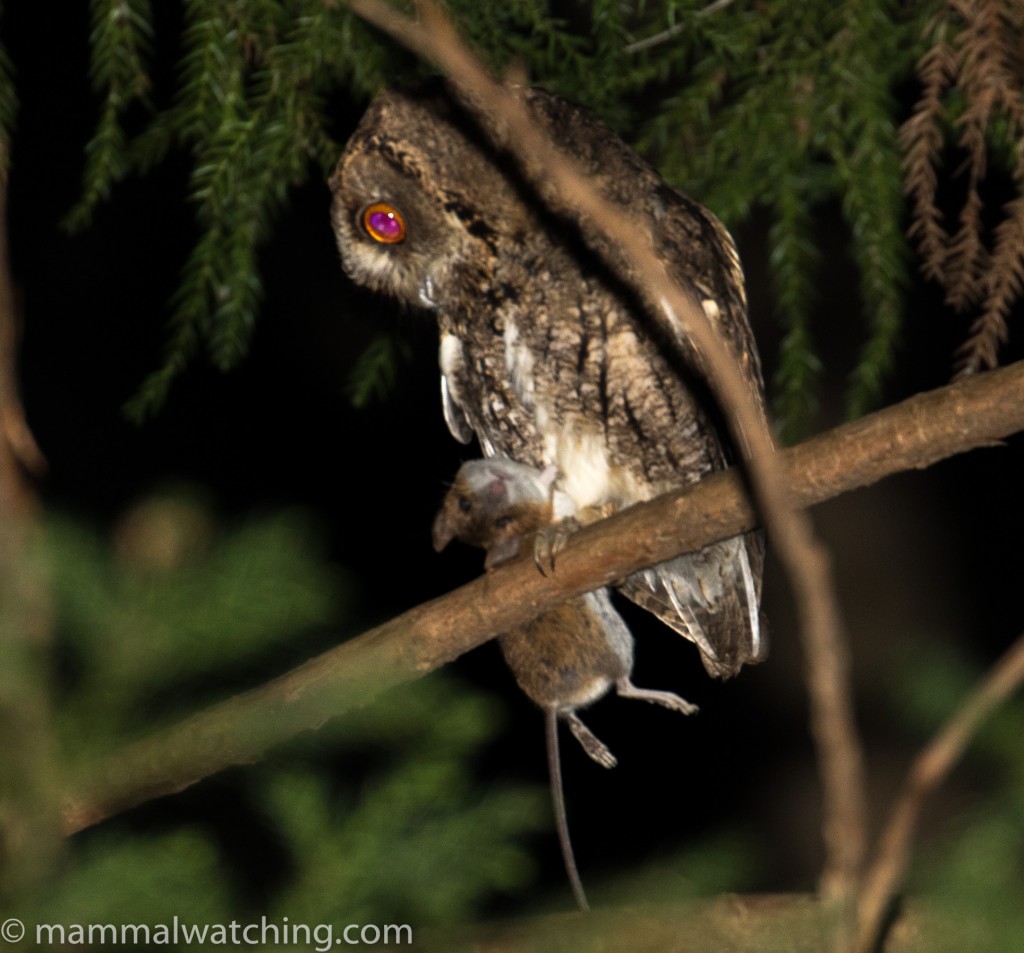
Japanese Field Mouse and a Collared Scops Owl
In April 2018 I spent a few hours at Lake Miike after dark. Sika Deer and Japanese Giant Flying Squirrels were common. I saw three Japanese Martens and a Japanese Raccoon Dog. But no badgers.
Elsewhere in Japan
There is plenty of other good mammal watching to be had in Japan including some good whale watching from several places, with species such as Bryde’s Whales and Baird’s Beaked Whales. Hokkaido Island also sounds good with stuff like Brown Bears and Northern Fur Seals (especially if you take the ferry there from Tokyo).
According to Richard Webb, Mi-ike near Kagoshima is a good spot for bats (they roost in shelters along the trails) and he saw a Japanese Marten there. He has also seen Iriomote Wild Cat on Iriomote Island (the jury still seems to be out about whether this as a sub-species of Leopard Cat or a full species).
Thanks to Susan Myers, Chris Cook, Kaz Shinoda and Richard Carden for their advice on where to go in Japan.
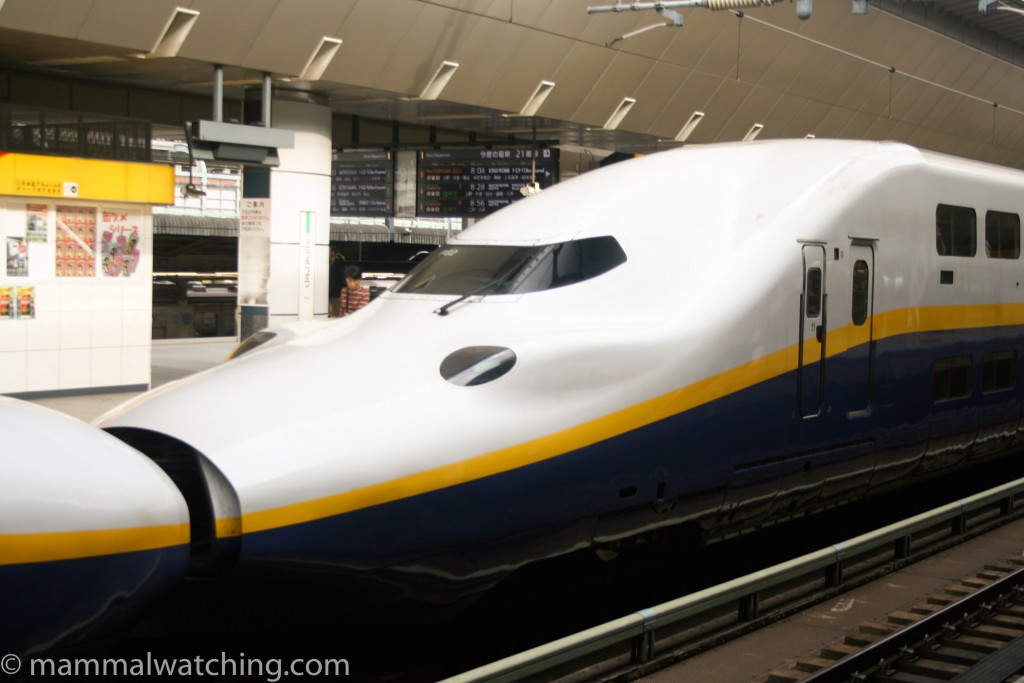
Community Reports
Hokkaido and a bit of Tokyo and Kyoto, 2024: Ben W’s report of what was more of a family trip but included 9 mammals including Sea Otter, Brown Bear and Raccoon Dog.
Eastern Hokkaido, 2023: Jon Hall, 3 nights & 4 species including Red Fox and Red Squirrel.
Northern Japan, 2023: Hugh Lansdown, 2 weeks & 9 species including Raccoon Dog, Japanese Squirrel and Orca. Great images.
Tsushima, Daito and Miyakejima Islands, 2019: Vladimir Dinet’s account of many small mammals from these islands.
Japan, August 2019: Vladimir Dinets, and many species in several locations including Bonin’s Flying Fox.
Kagoshima Prefecture, 2019: Vladimir Dinets, a few days & mammals including Japanese Weasel, Ryuku Flying Fox and Greater Japanese Mole.
Central Honshu, 2019: Vladimir Dinets, 1 week & mammals including Asian Black Bear, Mountain Mole and Lesser Japanese Mole.
Hokkaido and Honshu, 2019: Rick van der Weijde, 3 weeks & 17 species including Japanese Weasel and Grey Red-backed Vole.
Japan, April 2019: Vladimir Dinets, 10 days & 36 species including Japanese Badger, Japanese Serow, Dwarf Sperm Whale, Eden’s Whale and a lot of bats.
Japanese Macaques, Nagano Prefecture, 2019: Joe Morlan’s short account of seeing Snow Monkeys at Jigokudani Monkey Park in Yamanouchi.
Wayakama Prefecture, Honshu, 2019: Vladimir Dinets, 2 nights and a few mammals including Japanese Serow and Martens.
Central Honshu, 2019: Vladimir Dinets, 1 week with species including Japanese Serow and Japanese (lesser) Flying Squirrel.
Miyakojima, 2018: Vladimir Dinets’s report on the island with Ryuku Flying Foxes and a Japanese Weasel.
Ishigaki and Iriomote Islands, 2018: Vladimir Dinets’s on the islands with Iriomote Cat and some bats.
Kiso Valley, Honshu, 2018: Vladimir Dinets, 3 nights and several species including Japanese Hares and an Asiatic Black Bear.
Nagano, July 2018: Jon Hall, 3 nights & 11 species including Japanese Hare, Japanese Dwarf Flying Squirrels, Japanese Dormouse and Japanese Marten.
Nagano, Kagoshima and Nara, April 2018: Jon Hall, 3 nights & 5 species including Japanese Martens and Giant Flying Squirrels.
Amami and Tokuno Islands, 2018: Vladimir Dinets, 2 days & several species including Amami Rabbits, and Amami and Tokuno Spiny Rats.
Mount Takao (Western Toky0), 2018: An account of a one night walk with 5 species including Japanese Badger, Giant Flying Squirrel and a Raccoon Dog.
Northern Honshu, 2018: Vladimir Dinets, 2 days with species including Serow, Japanese Badger and Japanese Squirrel.
Hokkaido, 2018: Vladimir Dinets’s notes of a few species including Sable and Siberian Flying Squirrel.
Kirishima Mountains (Kyushu), 2018: Vladimir Dinets’s notes of 3 days with species including Japanese Badger, Japanese Weasel and Japanese Marten.
Kansai, 2017: Vladimir Dinets’s notes of 3 days with species including Japanese Giant Flying Squirrel, Raccoon Dogs and Serow.
Kasuga Primeval Forest (near Nara), 2017: Vladimir Dinets’s notes of a night spotlighting with 9 species including Japanese Weasel, Japanese Flying Squirrel and Japanese Badger.
Iriomote, 2017: Gareth Knass and Shaun Coyle, who in 24 hours on Iriomote saw Iriomote Wild Cat and Ryuku Flying Fox.
Amani Island and Tateshina, 2016: Jon Hall, 2 nights and 7 species including Amami Rabbit, Ryuku Long-furred Rat, Japanese Squirrel and Japanese Shrew-mole.
Taiwan, Korea and Japan, 2016: Dominque Brugiere, 5 weeks and lots of great mammals including – in Taiwan – Taiwan Serow, Siberian Weasel and Chinese Ferret Badger; in Korea – Finless Porpoise; in Japan – Japanese Badger, Japanese Marten, Amami Rabbit, Largha Seal and Japanese Weasels.
Korea and Japan, 2015: Romain Bocquier, 7 weeks & 17 species including, in Japan, Japanese Giant Flying Squirrel, Birdlike Noctule, Japanese Serow and Asiatic Black Bear in Japan, and, in Korea, Finless Porpoise.
Japan Winter Tour, 2014: Royle Safaris, 2 weeks & 7 species including Sable, Siberian Flying Squirrel and Lagha Seal.
Japan, 2014: Cheryl Antonucci, 2.5 weeks & 6 species including Japanese Serow and Sable.
Japan, 2014: Zoothera, 3 weeks & 20 species including Japanese Weasel, Japanese Badger and Japanese Hare.
Hokkaido, 2013: Coke Smith, 9 days & 6 species including Sable and Largha Seal.
Japan, 2012: Michel Watelet, 2 weeks & 8 species including Japanese Squirrel and Largha Seal.
Japan — Chubu Region, 2012: Coke Smith with several mammals including Japanese Serow and Japanese Squirrel.
Summer in Japan, 2010: Morgan Churchill, notes from a 2 months stay in Japan with species including Finless Porpoise, Pygmy Killer Whales, Japanese Squirrel and Japanese Marten.
Taga-Cho Bats, 2010: Damon Mitchell’s blog post on the cave at Taga.
Japan, 2007: Birdquest, 3 weeks & 17 species including Japanese Badger, Ryuku Rat, Japanese Weasel and Sperm Whale.
Northern Japan: Coke Smith, notes and photos from several trips. The mammals include a Japanese Serow and Japanese Field Mice.
Also See
is this a northern Leopard Cat or a feral Cat in Hokkaido? January 2025
Japanese Squirrel at a Karuizawa hotel, May 2019
Amami Rabbit RFI, Feb 2014
Resources
Hishashi Abe (Ed) 2005. A Guide to the Mammals of Japan. Tokai University Press. Is the best guide I have seen for Japan that is partly in English. Includes a page for every species with photos, measurements and other information. It also includes several newly described bats.


Leave a Reply
You must be logged in to post a comment.